This article was published in Scientific American’s former blog network and reflects the views of the author, not necessarily those of Scientific American
In the previous article we looked at the fact that it’s been 25 years since the 1993 release of the movie Jurassic Park. I went on to talk about the anticipation and build-up to the movie that I, as a dinosaur-obsessed teenager, experienced at the time. Here, we look at my thoughts on the movie itself.
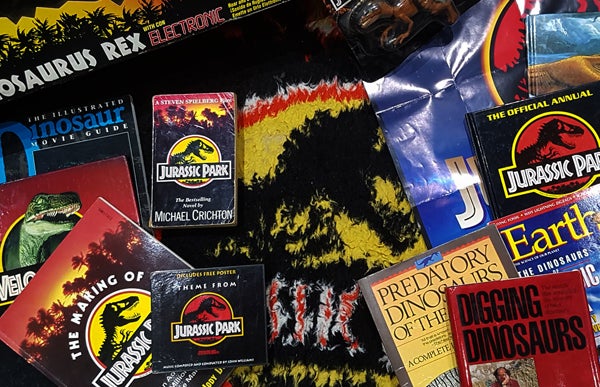
I’m not the only one who owns too much Jurassic Park stuff. Yes, I do have a Jurassic Park rug on the floor of my office. Some other relevant items sneak into shot as well... Credit: Darren Naish
Until recently, movies in the UK (yes, I’m sat in England while writing this) were released weeks to months after their release in North America. So, Jurassic Park Day in the US might have been June 9th but we here in the UK didn’t get it until July 16th. The agony. 1993 was (effectively if not literally) pre-email and pre-internet for ordinary citizens, so there was none of the instant discussion, spoilers and chatter we associate with movie releases today. Just tons and tons of coverage in newspapers, magazines, news TV shows and so on. I absorbed all of it (I worked in a newsagents at the time, so got to see everything in newspapers and magazines before it went on sale), gleaning further clues to the film’s plot and visuals. Eventually, I’d watched enough TV spots and promotional things to know the dialogue for some of the scenes by heart, plus a few seconds of the T. rex paddock attack were already familiar viewing. As a consequence, I already knew about the seismic shock thing. What? They seriously have an elephant-sized animal making loud bangs every time one of its feet hits the ground? I get that this is fun and suspenseful film-making… but it’s kinda dumb.
On supporting science journalism
If you're enjoying this article, consider supporting our award-winning journalism by subscribing. By purchasing a subscription you are helping to ensure the future of impactful stories about the discoveries and ideas shaping our world today.
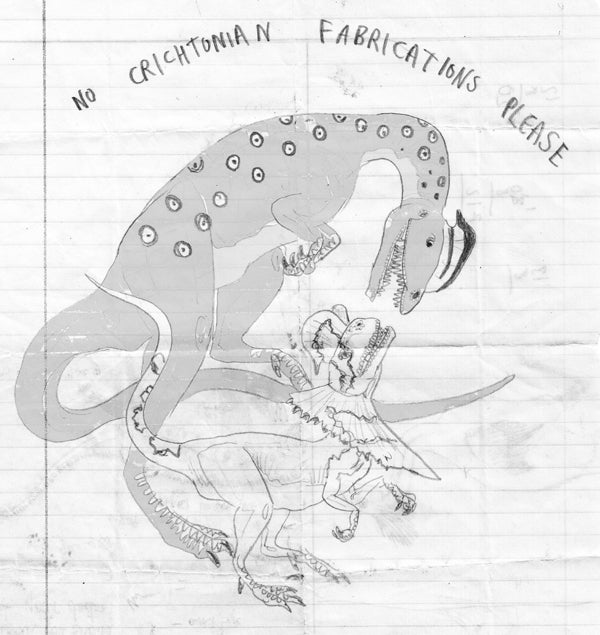
A cartoon I drew in 1993 and recently excavated from old piles of drawings. A ‘real’ Dilophosaurus (with old-fashioned bunny-hands, as was the tradition at the time) peers down at its miniature analogue created for the movie. Credit: Darren Naish
And I can’t say that I was a fan of the venom-spitting, neck-frilled dilophosaur either. Crichton’s dilophosaurs are venomous (ok, Crichton incorrectly says ‘poisonous’, the fool) but are otherwise proper, full-sized dilophosaurs (7 m or so long), so it was obvious that Spielberg and his people had sought to modify the creature for cinematic effect (the movie’s Dilophosaurus has to be small enough to fit into a car, small enough to look innocuous on first viewing, and be instantly distinguishable from the Velociraptors). Irksome but not soul-destroying, especially when you have to give credit to the idea that dinosaurs reconstructed from ancient DNA are either going to be new taxa or – as per the book and movie – are actually genetic hybrids, not pure dinosaurs
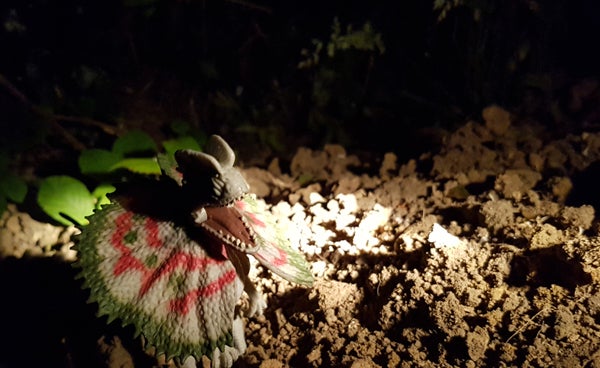
In this faithfully re-enacted scene from the movie, Denis Nedry discovers that the small, seemingly innocuous Dilophosaurus is less friendly than he supposed! Credit: Darren Naish
ANYWAY, the kindness of friends meant that I managed to get in on the evening of premiere night. And – WOAH – what a ride. Jurassic Park provides the most intense emotional high with its singing, striding, rearing brachiosaur and Grant’s reaction, one of the most memorable scenes in cinema. The T. rex attack scene is just sheer awesome and packed full of thrills and outstanding detail. The Gallimimus stampede, the sick Triceratops, the kitchen scene, the final battle in the rotunda… oh, oh, the Velociraptor feeding scene with the unfortunate cow! I actually had the sounds from that scene as my answering-machine message for a few months back in 1993. If, so far, I’ve seemed curmudgeonly or somewhat unimpressed or cynical as goes Jurassic Park, rest assured that this belies a committed love of the film, of a real emotional connection to and enthusiasm for it. I had a genuine concern on seeing it for the first time that I might not be able to keep my heart rate at a normal level for the duration, make of that what you will. After seeing it once in the cinema I went to see it again. And then again. And again. And, err, again. And again. In fact, I distinctly recall there being a TV ad at the time which stated “If you’ve seen it once, you haven’t seen it all!” – the first time I recall advertisers telling you that it’s ok to see a film at the cinema more than once. And when it came out on video (we’re talking VHS tape, kids)… well, I don’t know how many times I’ve re-watched my favourite bits, the T. rex attack in particular. The number is high.
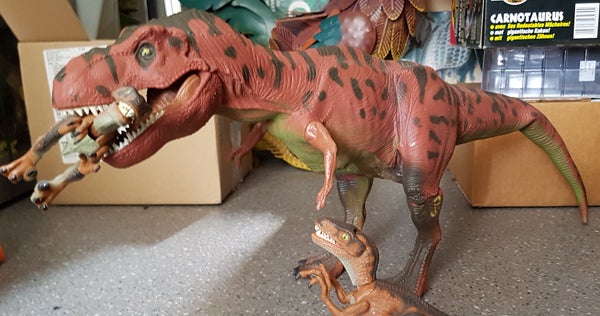
In the epic showdown that occurs in the visitor centre’s rotunda, we watch in awe as the tyrannosaur battles the two remaining raptors (by the way: what happened to the one that got shut in the freezer?). Credit: Darren Naish
And Jurassic Park is not just a film made for dinosaur nerds. Speaking as someone who enjoys movie, and not as a scientist who specialises on dinosaurs and other animals of the Mesozoic, Jurassic Park is a great movie. It has a story that you can buy into it. It has awesome, atmospheric and emotional shots and scenes that hit their targets. And you mostly like, and root for, the characters. Goldblum’s Malcolm could have been obnoxious and horribly arrogant (he’s mostly portrayed this way in the book) but he’s likeable and honourable when it counts. Even Nedry – who’s some sort of embodiment of greed in the book – didn’t deserve to die, and Attenborough’s Hammond is also played well as warm, likeable, granddaddy character. Kids in movies are often dire and high on the list of characters who need to be eaten by dinosaurs but I really like Tim and Lex in the movie: again, a contrast to the book, where Lex at least is annoying. Grant is stoic, hard to read and flat – which sounds like criticism but is, I feel, exactly how he should have been portrayed. And Sattler turns out to be a bit of a bad-ass who does things that feel right for an actual, real-world scientist (I’m thinking of the poop-handling scene).
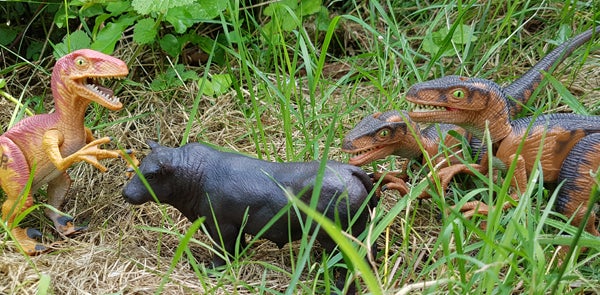
Jurassic Park ‘raptors’ are fed whole cows on a seemingly regular occasion, an unusual practice unlikely to happen in a real dinosaur park. If you aren’t familiar with these toys, the standard Velociraptor opens its mouth when its hindlimbs are squeezed together. The large, deluxe toy on the left produces a scream when its arms are moved. Credit: Darren Naish
Naturally, repeat viewings lead to the realisation that Jurassic Park contains an extraordinary number of continuity errors and such. It’s fun to talk about those things (and I often have) but it does, on reflection, sound like whiny undue criticism of what was clearly an intense, gruelling amount of work produced by a bunch of very talented people. My thinking on the sorts of errors I have in mind is that they’re essentially ubiquitous across cinema and TV but only observable once you obsess on detail after the millionth viewing and… something tells me that films aren’t exactly meant to be watched that way. Ok: that blast of air from the tyrannosaur doesn’t really come from its nostrils, but from the left-hand corner of screen. Illusion shattered. But did I notice this when I first watched the film in the cinema, like a normal person? No, I saw it, bought it, and though it was frikkin’ awesome.
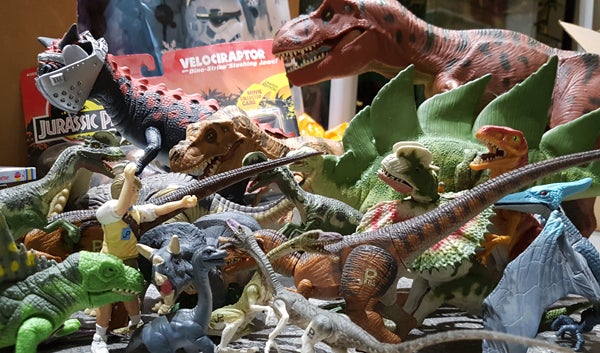
Yes, that is a Carnotaurus with some kind of metal contraption on its face. And other Jurassic Park toys... some of which are unopened in their boxes. Credit: Darren Naish
Next: the effects... and the sequels.
For more on Jurassic Park at Tet Zoo, see...
For relevant Tet Zoo articles on dinosaurs (there is a lot more in the archives), see...
Did dinosaurs and pterosaurs practise mutual sexual selection?
Ryan et al.'s New Perspectives on Horned Dinosaurs: a review
Junk in the trunk: why sauropod dinosaurs did not possess trunks (redux, 2012)
Dinosaurs and their exaggerated structures: species recognition aids, or sexual display devices?
Artistic Depictions of Dinosaurs Have Undergone Two Revolutions
Yi qi Is Neat But Might Not Have Been the Black Screaming Dino-Dragon of Death
The Integrated Maniraptoran, Part 3: Feathers Did Not Evolve in an Aerodynamic Context